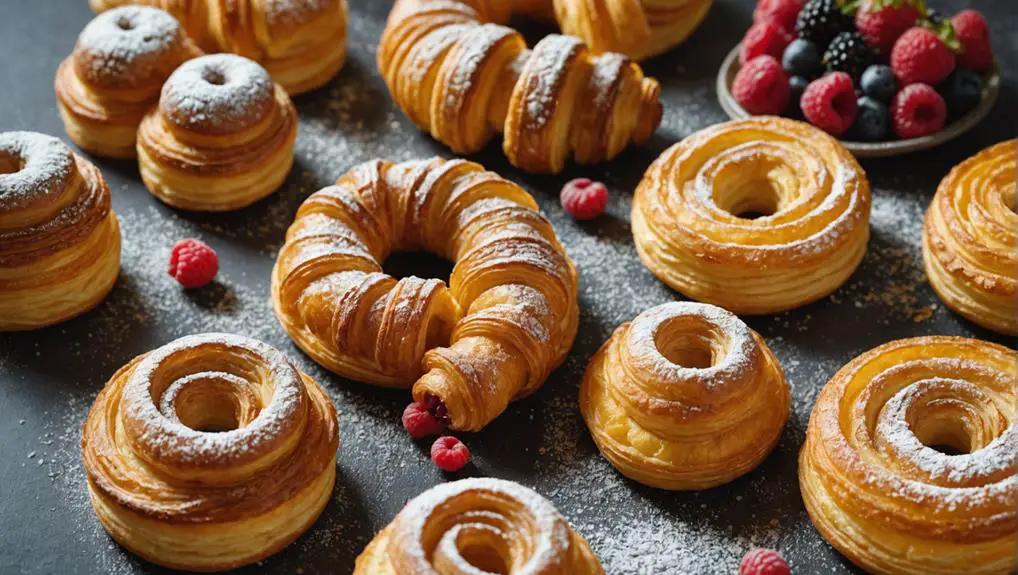When comparing Trdelník to traditional European pastries, distinct differences emerge that highlight their unique qualities. For one, Trdelník's cylindrical shape, achieved through a specific preparation method, sets it apart visually and texturally. Additionally, while many European pastries focus on rich, layered textures, Trdelník offers a simpler, sweeter experience. Furthermore, its communal nature fosters a sense of connection among those enjoying it. But what deeper implications do these differences have on cultural practices and culinary experiences?
Need cookware for your meal? Toolbox, a Pear to Pear rental marketplace, might be worth a look.
Quick Takeaways
- Trdelník's cylindrical shape is unique, contrasting with the typically flat or layered forms of many European pastries like croissants.
- The preparation method involves wrapping dough around a stick and roasting it, unlike the baking techniques of most other pastries.
- Trdelník features a simple flavor profile, primarily sweet with cinnamon, differing from the complex flavors found in filled pastries like Berliner Pfannkuchen.
- Its cooking process over an open flame imparts a distinct smoky flavor, a characteristic not common in most European baked goods.
- Trdelník is often associated with communal eating and festive occasions, highlighting its cultural significance compared to the individual servings of many pastries.
Origin and Cultural Impact
What makes Trdelník so emblematic of Central European culture? This sweet pastry, rooted in the culinary traditions of the Czech Republic and Slovakia, showcases a blend of local baking techniques and communal eating practices. Its cylindrical shape and warm, sugary exterior capture the essence of Central European street food culture, especially in bustling urban centers like Prague.
The origins of Trdelník spark debate, with claims from both Slovakia's Skalica and Hungary's Kürtőskalács, highlighting the pastry's cultural significance across multiple European countries. Each region takes pride in its version, contributing to a shared culinary heritage that fosters connection and community.
Local bakeries have embraced Trdelník, transforming it into a trendy delicacy that attracts both locals and tourists alike.
As a symbol of growing street food culture, Trdelník reflects the fusion of flavors and festive occasions celebrated throughout the region. Its popularity extends beyond borders, resonating with those who appreciate the charm of traditional pastries and the experience of sharing food.
Ultimately, Trdelník stands as a representation of the vibrant cultural tapestry of Central Europe, inviting everyone to savor a piece of its rich history.
Unique Preparation Techniques
In the heart of Trdelník's preparation lies an enchanting technique that sets it apart from many traditional European pastries. The process begins with a simple yet significant act: wrapping dough around a stick, which is then roasted over an open flame or gas fire. This method not only creates the pastry's unique cylindrical shape but also imparts a delightful smoky flavor, elevating the overall experience.
Unlike the layered techniques seen in croissants or eclairs that rely on steam for their flaky textures, Trdelník's dough is rolled and coated in a mixture of sugar and cinnamon before cooking. This caramelization adds a sweet, crunchy exterior.
When it's ready, the warm Trdelník is usually served adorned with various toppings, such as whipped cream or nuts, making it a versatile treat.
Trdelník's continuous rotation during cooking contrasts sharply with pastries like puff pastry, which involve intricate folding and rolling of butter. While both styles bring joy, Trdelník's preparation is a celebration of simplicity and warmth, inviting those who serve it to indulge others with a unique culinary creation.
Flavor Profiles and Textures

When comparing flavor profiles and textures, Trdelník stands out with its unique sweet, slightly flaky texture, often enhanced by a generous dusting of cinnamon and sugar. This pastry, often served warm, captivates with an inviting aroma and visual appeal that makes it a popular choice among street vendors.
- Trdelník's flavor profile is mild yet delightful, emphasizing sweetness.
- European pastries, like the croissant, boast a rich, layered texture due to puff pastry.
- German Berliner Pfannkuchen introduces a more complex flavor with fillings like jam or custard.
- Viennese variations of chimney cakes offer a crunchier texture with a pronounced spice aroma.
- Italian cannoli combine visual appeal with intricate flavor combinations through ricotta and chocolate.
While Trdelník's simplicity shines through its cinnamon-sugar coating, the depth of flavor in pastries like éclairs and millefeuilles comes from sophisticated fillings and elaborate presentations.
This contrast highlights how culinary traditions shape not just taste, but also the overall experience of indulging in these pastries.
Fundamentally, Trdelník offers a sweet, visually striking option, while European pastries provide a more complex interplay of flavors and textures.
Common Questions
What Is the Difference Between Kurtos and Trdelník?
Kurtoskalacs and Trdelník differ in origin, preparation, and toppings. While Kurtoskalacs boasts traditional Hungarian roots and PGI status, Trdelník embraces trendy variations, appealing more to tourists and offering a wider range of flavorful options.
Is Chimney Cake the Same as Trdelník?
The sweet symphony of chimney cake and Trdelník plays similar notes, yet each pastry sings its own song. Though their shapes and baking methods mirror one another, subtle differences in texture and flavor set them apart.
What Is Another Name for Trdelník?
Trdelník, often known as chimney cake, delights many with its sweet, crispy exterior. In Hungary, it's called kurtoskalacs, while in Slovakia, locals refer to it as trdlo, showcasing its rich cultural significance across Central Europe.
What Is the Famous Czech Pastry Called?
Trdelník, the crown jewel of Czech pastries, mesmerizes with its enchanting cylindrical shape. It's a beloved treat, traditionally baked over open flames, and tantalizes taste buds with sugar and cinnamon, often enjoyed at festive gatherings.
Wrapping Up
Trdelník, with its distinctive cylindrical form and communal cooking method, truly sets itself apart from traditional European pastries. Notably, in the Czech Republic, it's estimated that over 2 million Trdelníks are sold annually at festivals and markets, highlighting its popularity and cultural significance. This festive treat not only embodies a unique flavor profile but also fosters connections among those who share it, making it a delightful symbol of togetherness in culinary traditions.
